How To Use Stereo Mix And Microphone At The Same Time Windows 10
Desire to catechumen some of those old cassette tapes to digital MP3s? Desire to utilize voice dictation software? Want to record some audio from a website that streams music? Want to use your PC as a makeshift karaoke auto? Getting Windows to record all those sounds isn't ever and then easy or straightforward.
Windows allow more than than 1 audio device, a "feature" that usually makes troubleshooting sound bug needlessly complicated. This is peculiarly true when recording sound, given that Windows can simply record from i source at a time.
A unmarried audio device may have two or three audio inputs: an analog (mono) microphone input, an analog stereo "Line-In" or auxiliary input, and sometimes a digital Due south/PDIF input. Also, special devices, like voice dictation headsets and Goggle box tuner cards, have their ain inputs.
Sound Inputs in Windows
All the inputs for all your audio devices are listed in Control Panel ➝ Audio ➝ Recording tab.
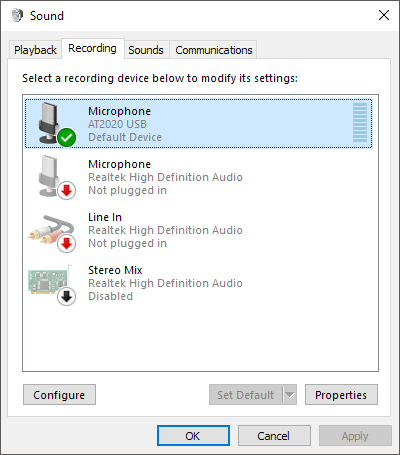
To choose the default audio source, highlight the device you want to use and click Set Default. Virtually applications will automatically apply the default device to record sound, simply some (particularly vox-dictation software) require that you cull a source separately in the application itself. If you speak to your mic, the mic level should rise existent time:

If you select the microphone and click on Properties, you'll exist able to adjust quite a few settings. On the General tab, you lot get some basic data about the device and you can cull to disable it here if y'all like. The more than interesting characteristic is on the Listen tab.

This is a cool characteristic whereby yous can play the sound that is being recorded by your microphone directly to your speakers. So every bit you talk into the microphone, the sound volition be played in real fourth dimension to your speakers. Evidently, this will piece of work much better if you are using headphones, so that the sound from the speakers doesn't feed back into the microphone.
Bank check the Listen to this device box and select the device yous desire to play the audio dorsum through. By default, it's set up to your default playback device, which will normally be your headphones or speakers. If yous have multiple playback devices, you can choose from the dropdown listing. Click the Utilize button and whatsoever sound picked up past your mic should play through your speakers in real time.
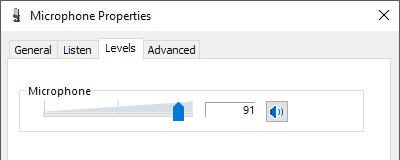
On the Levels tab, you tin can adjust the sensitivity of the microphone depending on your needs. On the Advanced tab, you can change the default format for the audio. Past default, it's set to one aqueduct, 16 fleck and 44100 Hz, which is CD quality. There are many other options, including DVD quality, which you tin can utilize if you have a loftier-quality microphone.
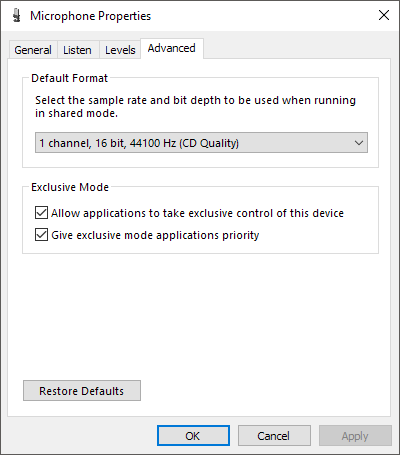
If yous become back to the Recording tab, select Microphone and click on Configure, the Speech Recognition dialog volition announced. Hither you can setup voice control for Windows, railroad train the computer to understand your voice better and setup your microphone properly for speech recognition.
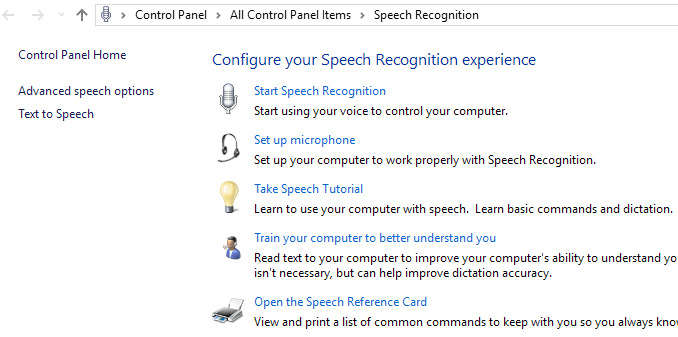
Lastly, back on the Recording tab, you may discover an option called Stereo Mix. If y'all don't have this choice, it ways your sound menu doesn't support the feature.
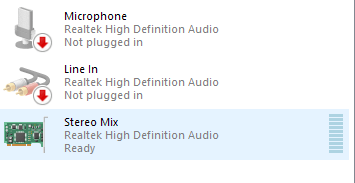
So what does it do? Basically, it lets you tape any sound that is playing on your computer. For example, if yous are watching a YouTube video on your calculator, how would y'all record the audio? You could try to place a microphone next to your speakers, merely that'due south non an platonic way to tape that sound. Stereo Mix volition let yous open a audio recording program on your computer, choose Stereo Mix every bit the input and information technology'll tape whatever audio comes out of your computer.
If you apply the default Sound Recorder or Vox Recorder (Windows 10) apps, they will automatically record from Stereo Mix equally long as you disable the microphone first. If yous're using a program like Audacity, just change the sound input to Stereo Mix. Using this input, you can record music playing on your reckoner, audio from a video playing on your computer, or whatsoever other sound from your PC.
Hopefully, this gives y'all a good overview of the different audio inputs in Windows and how you can utilize them to record the audio you demand. If you take any questions, experience free to mail service a comment. Enjoy!
Do not share my Personal Information.
How To Use Stereo Mix And Microphone At The Same Time Windows 10,
Source: https://helpdeskgeek.com/how-to/record-sound-using-line-in-microphone-windows/
Posted by: loftontreave.blogspot.com


0 Response to "How To Use Stereo Mix And Microphone At The Same Time Windows 10"
Post a Comment